Growing a concrete business depends on steady, qualified leads. Without a system to bring in potential clients, even the best service struggles to stay competitive.
To generate concrete leads, use Google Ads for high-intent traffic, build SEO-optimised landing pages, run social media ads to increase awareness, and form partnerships with local businesses to drive referrals. Focus on clear targeting, track key performance metrics, and refine strategies to improve conversions and return on investment.
In this guide we’ll explain how lead generation works, why it matters, and how to track success. You’ll learn how to reach commercial contractors, residential customers, and property managers using both paid and organic channels. You’ll also get practical steps to build a leads pipeline that delivers real business outcomes.
Getting Free Leads for Concrete Work
Free lead sources are a great starting point for any concrete company, especially if you’re working with a limited budget. Online directories like Yelp, Google Maps, and HomeAdvisor offer free listings that can bring in local traffic. Take time to upload photos, fill in your business details, and collect reviews, these small steps can build trust quickly.
You can also create a free Facebook page or post in local groups and forums like Nextdoor to reach homeowners looking for services.
Referrals and informal partnerships with related contractors (like landscapers or pavers) can also bring in leads at no extra cost. These methods may take effort and consistency, but they can bring in steady leads over time.
Buying Leads for Concrete Work
Buying leads may sound appealing because it promises quick results, but it comes with trade-offs. Services like Angie, Thumbtack, and eLocal sell you contact info for people looking for concrete work. These leads are easy to access and often come at a flat rate per inquiry.
The downside is that these leads are usually not exclusive, and you’re often competing with several other contractors for the same job. Many of these prospects haven’t heard of your company before, so closing the deal is harder.
Lead quality varies, and you’re locked into a fixed cost-per-lead that can’t be optimized. If you decide to buy leads, look for platforms that offer exclusivity and avoid long-term contracts unless you’ve tested the results first.
What Is Lead Generation for Concrete Work?
Lead generation connects your business with people actively searching for concrete services. It includes:
- Strategic outreach using paid ads (PPC)
- Organic visibility through search engine optimisation (SEO)
- Building trust via social media and project showcases
- Outreach through outbound appointment setting
Concrete lead generation means creating systems that attract the right audience, whether residential homeowners planning driveways or general contractors managing commercial projects.
Why Use Lead Generation in the Concrete Industry?
Not all marketing channels bring results. Lead generation keeps your sales pipeline full with minimal waste.
It helps you:
- Control your marketing budget
- Focus time on qualified prospects
- Build predictable revenue streams
A consistent lead flow gives your sales team more opportunities to close jobs. For example, a contractor using Google Ads for stamped concrete patios may receive ten inquiries weekly, with five converting into estimates. That’s repeatable, measurable growth.
Why Google Search Ads Are the Best for Concrete Leads
When it comes to generating quality leads for concrete services, Google Search Ads stand out as the most reliable option. These leads are highly targeted, people are already searching for terms like “concrete repair near me” or “patio concrete contractor.” That means they’re more likely to call, fill out a form, or request a quote right away. The leads go straight to you, and since you’re not sharing them with other companies, you can follow up, build a relationship, and even turn one job into multiple through reviews and referrals.
Another big advantage is the control. You can choose exactly which keywords you want your ad to show for and block the ones that attract DIYers or price shoppers. You also have the flexibility to test different offers, landing pages, or job types, whether you want more patio work, decorative concrete, or commercial projects. Over time, with testing, your cost per lead can drop, making the campaign more profitable.
Pros and Cons of Google Ads for Concrete Services
Pros:
- Leads are exclusive to you, not shared.
- Buyers are pre-qualified and actively searching.
- You can target specific job types like patios, decks, or commercial.
- Full control over keywords and ad copy.
- You can lower your cost per lead with testing over time.
- No long-term contract required, just pay per click.
Cons:
- It’s not cheap to start. You’ll likely need a decent budget to see results.
- It takes time to optimize. Better results come from ongoing testing and adjustments.
- It’s not beginner-friendly. Running it yourself means learning the platform, writing ads, managing budgets, and making changes regularly.
- Results vary by region. More competition means higher costs per click.
- You’ll need a functioning website for your ads to lead somewhere.
Top Benefits of Lead Generation for Concrete Services
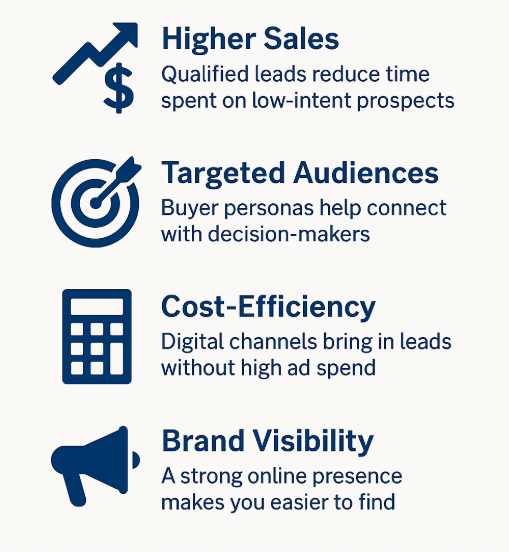
1. Higher Sales from Qualified Leads
Effective lead systems filter out time-wasters. By attracting buyers ready to hire, you reduce sales friction and close faster.
Example: A concrete contractor in Texas ran Facebook ads showcasing finished driveways. With location targeting and interest filters, the campaign brought in 300 leads in three months. Follow-up emails turned 25% into booked jobs.
2. Reach Targeted Audiences
Buyer personas allow you to speak directly to pain points. Instead of casting a wide net, you connect with decision-makers.
Use data to identify:
- Project types (residential patios vs. commercial slabs)
- Urgency (timeline to build)
- Preferred communication channels
Tactics like remarketing help you stay top-of-mind for people who previously interacted with your website or ad.
3. Cost-Efficient Marketing
Digital lead generation provides a strong return on investment compared to traditional ads.
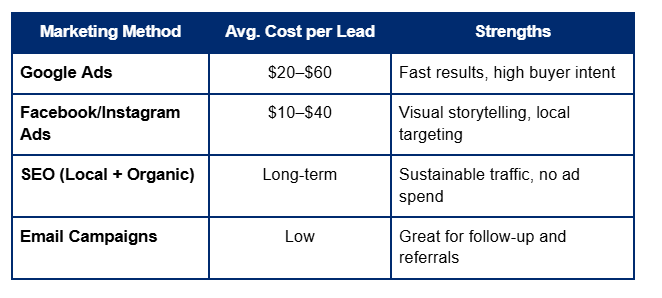
Budget-conscious strategies such as geotargeted PPC and SEO content tailored to your service area drive leads without overspending.
4. Improved Brand Visibility
Lead generation increases your online footprint. Visibility builds trust, especially in competitive markets.
Ways to improve awareness:
- Post project photos on Facebook, Instagram, and LinkedIn
- Optimise your Google Business Profile
- Respond to reviews and questions online
Over time, your business becomes the go-to option for local concrete work.
How to Create a Lead Generation Strategy for Concrete Work
Every lead generation strategy starts with a clear plan. For concrete businesses, that means aligning your online marketing tools –Google Ads, SEO, landing pages– with a deep understanding of your customer base.
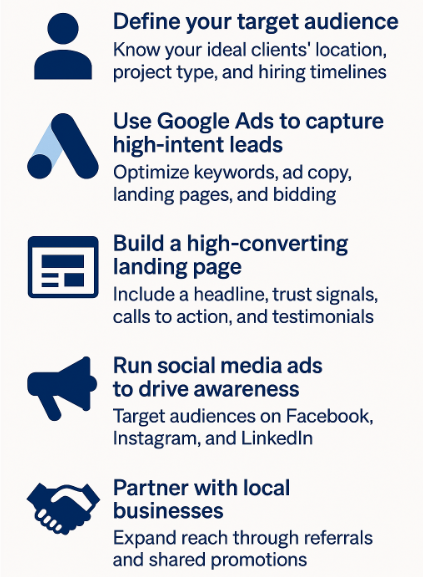
1. Define Your Target Audience
Start by identifying who you want to reach.
Are you targeting homeowners needing patios and driveways? Or are you after commercial builders looking for large-scale concrete pours?
Knowing your audience helps you tailor both your messaging and your channels. Use data to answer key questions:
- Where do your ideal clients live?
- What challenges do they face with concrete projects?
- How do they typically hire a contractor?
Build customer profiles (buyer personas) based on:
- Location and income level
- Project type (residential vs. commercial)
- Search behaviour and buying timelines
This process sharpens your targeting and increases conversions by speaking directly to the needs of your audience.
2. Use Google Ads to Capture High-Intent Leads
Google Ads (formerly AdWords) gives you direct access to people actively searching for concrete services. A well-run campaign ensures your company shows up when it matters most.
But results depend on more than just turning on ads. Success comes from consistent optimisation:
- Keyword Strategy: Use terms your audience actually searches, like “concrete driveway contractors near me” or “commercial slab pour quote.”
- Compelling Ad Copy: Write short, action-focused headlines. Highlight unique value—fast turnaround, licensed and insured, local references.
- Optimised Landing Pages: Send traffic to pages built to convert. Match page content with your ad text.
- Smart Bidding: Adjust bids based on performance, device, and location. Set budgets around ROI, not just clicks.
Consider this: A concrete contractor in Florida spent $2,000/month on Google Ads. After refining keywords and rewriting landing page content, their conversion rate doubled (from 5% to 10%) cutting cost per lead in half.
3. Build a High-Converting Landing Page
Your landing page is where ad clicks become actual inquiries.
Design matters. So does clarity. Avoid clutter. Use strong headers, sharp images, and quick-loading mobile formats. Show before-and-after photos of completed work.
Key elements to include:
- A short, benefit-driven headline (“Expert Concrete Solutions for Homes and Businesses”)
- Trust signals (licences, insurance, reviews)
- Calls to action (“Request a Free Estimate”)
- Testimonials or project highlights
This one page should guide visitors through the decision fast.
4. Run Social Media Ads to Drive Awareness
Social media isn’t just for brand exposure, it can drive real leads. Platforms like Facebook and Instagram offer location targeting, interest filters, and visual storytelling.
Facebook: Use photo carousels and project videos to grab attention. Tell the story behind each job.
Instagram: Leverage Reels to show job progress. Visual storytelling creates engagement.
LinkedIn: Ideal for connecting with commercial builders, architects, and project managers. Share blog posts or video walkthroughs.
Real-world example: A Texas concrete company ran Facebook video ads targeting new homeowners in specific ZIP codes. Engagement jumped 300% in two weeks, generating 40 inbound leads from one campaign.
5. Partner with Local Businesses
Strategic partnerships extend your reach without raising your ad budget.
Think about who shares your customer base. Landscapers. Pool builders. General contractors. Property managers.
How collaboration helps:
- Referrals flow both ways
- Joint offers increase project value
- Shared promotions expand visibility
For instance, if you work with a fence contractor, you can bundle services and co-market your work on social media. A joint project post may reach twice the audience compared to posting alone.
Best Practices for Lead Generation in the Concrete Industry
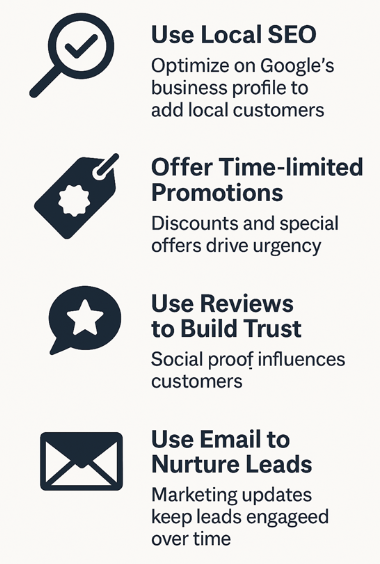
There’s no single path to lead success. But certain strategies consistently deliver strong results when applied with focus and consistency.
Use Local SEO
Local SEO brings high-quality leads to your website without paying for each click. Start by optimising your Google Business Profile.
Update it with:
- Business hours and contact info
- Service categories and project photos
- Positive reviews and responses
Use local keywords in your website content. Think: “Texas concrete slab installer” or “driveway resurfacing in Houston.”
Hosting a local blog post or showcasing neighbourhood projects helps you rank for “near me” searches, which are often the final step before a customer contacts you.
Offer Time-Limited Promotions
Discounts and seasonal offers prompt action. People are more likely to request a quote when they feel time pressure.
Examples:
- 10% off summer bookings for patio work
- Free consultation on stamped concrete
- Referral discount for friends and family
Promotions also help PPC and SEO campaigns stand out. A contractor in Arizona added a spring offer headline to all ads. Conversion rates rose 18% in three weeks.
Use Reviews to Build Trust
Social proof influences decision-making. That’s especially true for concrete work, where clients often fear poor quality or unfinished jobs.
What to do:
- Ask for a review after each job (ideally on Google)
- Feature reviews on landing pages
- Post review highlights on social media
Go one step further by using video testimonials or job site photos. These add credibility and help potential clients visualise outcomes.
Use Email to Nurture Leads
Not all leads convert right away. Email marketing helps you stay in touch with potential clients until they’re ready to move forward.
Segment your list:
- New inquiries
- Past customers
- Commercial vs. residential prospects
Send helpful updates:
- Project tips
- Current promotions
- Case studies
Write subject lines that spark interest (“Stamped Concrete: Before and After”) and always include a clear next step.
How to Measure the Success of Your Lead Generation Strategy
Generating leads is only part of the job. To improve results over time, you need to measure what’s working and what isn’t. That starts with tracking specific metrics that show how your efforts are performing.
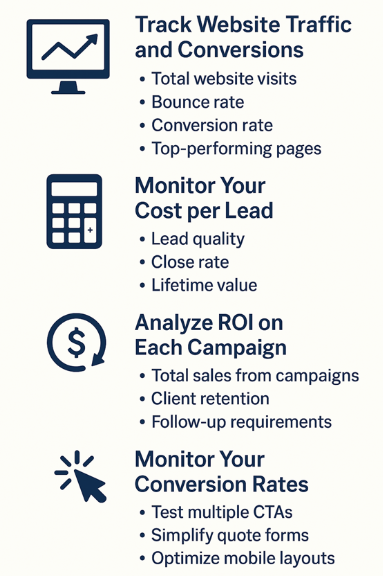
These numbers give you clarity. They help you fine-tune campaigns, control spend, and focus on channels that bring results.
Track Website Traffic and Conversions
If people visit your site but don’t take action, you’re losing opportunities.
Use tools like Google Analytics and HubSpot to monitor:
- Total website visits
- Bounce rate (how fast people leave)
- Conversion rate (form fills, calls, quote requests)
- Top-performing pages
Suppose 2,000 visitors land on your concrete services page in a month, but only 20 fill out a quote form; that’s a 1% conversion rate. If you update the call-to-action button or improve your project photos and conversions jump to 3%, that’s a 200% increase in leads.
Track traffic sources too. Did the visitor come from a Google search, a Facebook ad, or a referral from Yelp? Knowing where your leads originate helps you double down on high-value channels.
Monitor Your Cost Per Lead
Cost per lead (CPL) shows how much you’re spending to get each inquiry.
To calculate CPL:
Total marketing spend ÷ Number of leads generated = Cost per lead
If you spent $1,000 on Facebook ads and received 50 leads, your CPL is $20.
But numbers alone don’t tell the whole story. You also need to assess:
- Lead quality (Do they convert into jobs?)
- Close rate (Are they serious buyers or price shoppers?)
- Lifetime value (Will this client hire you again?)
Compare performance across channels:
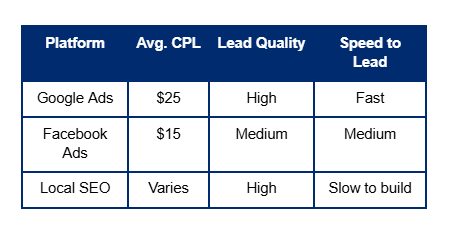
You might accept a higher CPL on Google Ads if the conversion rate is stronger than with social platforms.
Analyse ROI on Each Campaign
ROI matters more than impressions or clicks. You’re in business to generate revenue, not just traffic.
Return on investment (ROI) measures how well a lead source turns marketing spend into actual profit. For every dollar spent, how much do you get back?
(Revenue – Cost) ÷ Cost = ROI
If a $2,000 ad campaign brings in $10,000 in contracts, your ROI is 400%.
Evaluate ROI monthly or quarterly. Adjust your campaigns based on what produces long-term returns. That includes reviewing:
- Total sales from each campaign
- Client retention from each lead source
- Follow-up requirements to close the deal
Email campaigns and SEO may cost less up front but yield higher ROI over time compared to paid ads, which produce faster, but often costlier, results.
Monitor Your Conversion Rates
Conversion rate measures how well your site or ad turns a visitor into a lead.
A high click-through rate (CTR) without conversions means your message attracted attention, but didn’t inspire action. Use tools like:
- Google Ads’ built-in conversion tracking
- Facebook Pixel for campaign-specific insights
- CRM platforms (e.g., HubSpot or Salesforce) to track lead journeys
Steps to improve conversion rates:
- Test multiple calls-to-action (CTAs). “Get a Free Estimate” may outperform “Contact Us Today.”
- Simplify quote forms. Ask for only what you need to start the conversation.
- Optimise mobile layouts, especially for service pages and landing pages.
Monitor performance regularly. A 1% shift in conversion rate can drastically change lead volume.
Ready to Grow Your Concrete Business with Qualified Leads?
Getting consistent, high-quality Concrete Leads in the concrete industry doesn’t happen by chance. It takes a focused strategy, the right tools, and expert management of paid and organic channels.
At Falcon Digital Marketing, we help concrete contractors like you build scalable lead generation systems that deliver real results. Whether you’re looking to fill your calendar with residential jobs or land larger commercial contracts, we know how to position your business in front of the right audience at the right time.
Our team handles every step:
- Google Ads campaign creation and ongoing optimisation
- Audit landing pages to convert clicks into calls
- Local strategies that build long-term visibility
- Transparent reporting that tracks every lead and dollar
You bring the expertise in concrete, we bring the leads. Contact Falcon Digital Marketing today!
FAQ
How can a PPC management company help me get leads for concrete work?
A PPC agency manages keyword research, ad creation, bidding strategies, and ongoing optimisation. At Falcon Digital Marketing, we also track performance and adjust campaigns to improve ROI.
What types of businesses can benefit from using PPC to get leads for concrete work?
Both small contractors and larger commercial firms can benefit. PPC allows precise targeting, which means even local businesses with limited budgets can generate consistent leads.
Can I generate leads for concrete work without using PPC?
Yes. SEO, social media, and email marketing all generate leads over time. But PPC is the fastest way to capture high-intent customers. A mix of methods creates a stable pipeline.
Other Articles You Might Also Be Interested In:

